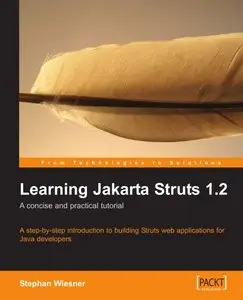Stephan Wiesner, "Learning Jakarta Struts 1.2: a concise and practical tutorial: A step-by-step introduction to building Struts web applications for Java developers"
PP | 2005 | ISBN: 190481154X | 220 pages | PDF | 6,2 MB
PP | 2005 | ISBN: 190481154X | 220 pages | PDF | 6,2 MB
A step-by-step introduction to building Struts web applications for Java developers
Learn to build Struts applications right away
Build an ecommerce store step-by-step using Struts
Well-structured and logical progression through the essentials
In Detail
Jakarta Struts is an Open Source Java framework for developing web applications. By cleanly separating logic and presentation, Struts makes applications more manageable and maintainable.
Since its donation to the Apache Foundation in 2001, Struts has been rapidly accepted as the leading Java web application framework, and community support and development is well established.
Struts-based web sites are built from the ground up to be easily modifiable and maintainable, and internationalization and flexibility of design are deeply rooted. Struts uses the Model-View-Controller design pattern to enforce a strict separation between processing logic and presentation logic, and enables efficient object re-use.
The book is written as a structured tutorial, with each chapter building on the last. The book begins by introducing the architecture of a Struts application in terms of the Model-View-Controller pattern. Having explained how to install Jakarta and Struts, the book then goes straight into an initial implementation of the book store. The well structured code of the book store application is explained and related simply to the architectural issues.
Custom Actions, internationalization and the possibilities offered by Taglibs are covered early to illustrate the power and flexibility inherent in the framework. The bookstore application is then enhanced in functionality and quality through the addition of logging and configuration data, and well-crafted forms. At each stage of enhancement, the design issues are laid out succinctly, then the practical implementation explained clearly. This combination of theory and practical example lays a solid understanding of both the principles and the practice of building Struts applications.
Not all books on AvaxHome appear on the homepage.
In order not to miss many of them follow ebooks section (see top of each page on AH)
and visit my blog too :)
In order not to miss many of them follow ebooks section (see top of each page on AH)
and visit my blog too :)
NO MIRRORS according to the rules



